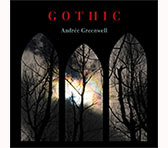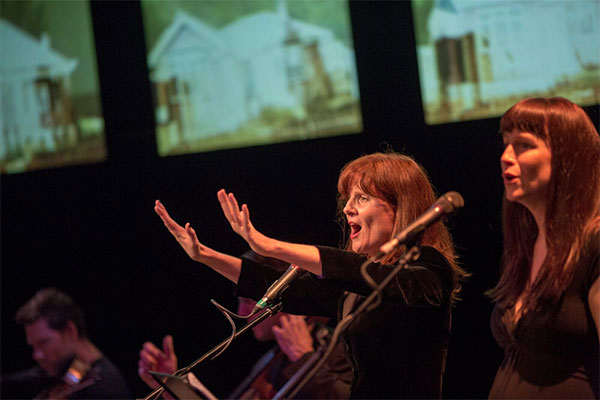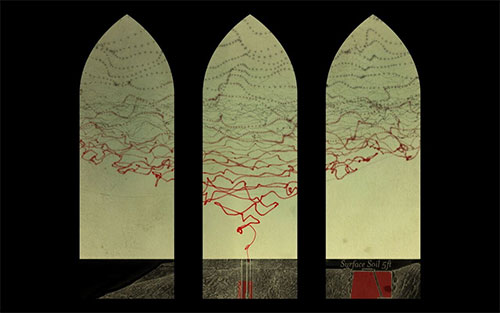31 October 2018
Gothic

Andrée Greenwell writes Gothic: a project exploring expressions of European, Australian and American gothic from medieval to contemporary times. Gothic had its premiere season in 2015, and returns to Sydney and Melbourne in November 2018, with performances at Riverside Theatres, Parramatta, on Friday 9 November and at the Playhouse, Melbourne Arts Centre, on 25 November.
Gothic is a multidisciplinary concert of European, Australian and American gothic expressions in words and music, from medieval to contemporary times. I wanted to combine songs new and old, with a sense of deliciousness in revisiting some well-loved songs, and then find contemporary gothic expressions by making new ones.
Early in the project's development, I had a conversation with writer and academic Jen Craig, who talked about 'gothic' expressions as mutating and updating over time, and the fact that this has continued in Western culture preceding medieval times. This led me to think about making my own gothic work as part of this update, a place for me to inhabit with an instrumentation that would speak across traditional and contemporary song styles.
A number of factors informed the project. Despite being an untrained singer, I wanted to perform my own music again, having enjoyed revisiting this alongside vocalist Donna Hewitt (also a composer and electronic instrument designer), with a seven-piece band in The Villainelles. The idea of a gothic-themed concert was so simple, yet held immense potential - to play with 'gothic' in song, across history and in a postmodern framework.
The possibility of historic leaps in time, culture and location provided a delectable excuse for me to collide traditional instrumentation with contemporary technology, which I love. I decided on an instrumentation of two vocalists - myself and a soprano, with string quartet, electric guitar and sequenced and creative audio. This was a rich and flexible palette to work with. A bunch of fantastic musicians made that all real - soprano Julia County, violinists Ewan Foster and Stephanie Zarka, violist James Eccles and cellist Geoffrey Gartner. I invited David Trumpmanis to work on the project, because of his reputation as a music engineer, and also because he plays electric guitar. While the stories and themes are dark at times, I had immense fun being creative with the arrangements and instrumentations, including in my own compositions.
Finally, there is the expressive aspect. I wanted to achieve a multidisciplinary concert led by music, but still integrating imagery, to provide a different experience to recent hyper-real representations of gothic in screen culture. I find that graphic representations often favour horror and gore, to end up losing mystery, complex tensions and eroticism present in the private readings of (gothic) literature. Also, I was thinking about the sensuality of post-punk gothic songs and the performance of that - the impact of the sonic and the visual style that made for a unique subculture expression and recent meaning of gothic. In the music and its grain, I hoped for a performative experience that was variously eerie, disturbing, sensual and tense.
Altogether, five Australian writers made lyric contributions - Hilary Bell, Alison Croggon, Maryanne Lynch, Hugo Race and Felicity Plunkett. I had a thought to include a section based upon the short story 'Lost, A True Tale From the Bush!' about three children who went missing in Wimmera, which I had found compelling in my Grade Four reader.
I did not pursue the idea for the song cycle, because it overlapped other narrative themes already in the song list, but in conversations with writer Maryanne Lynch, we talked about the importance of Australian gothic representations in the work. This is now most strongly realised in the wonderful lyric that ex-Bad Seed, Hugo Race, wrote for me about the tragic end of the painter Brett Whiteley's life, in 'Death at the Beach Motel'. Wanting to include a contemporary gothic story, I asked Maryanne Lynch to write a lyric based upon the story of Kerstin Fritzl, who was detained by her father/grandfather beneath the family home, together with her mother and siblings, for the first nineteen years of her life. A music video-clip of this song, made quite separately to the performance of Gothic, was shot by cinematographer Justine Kerrigan and edited by James Manché.
Building on my music theatre works The Hanging of Jean Lee and Dreaming Transportation, I thought it would be great to use visual projections, but I decided that, on this occasion, I would not direct the images. It worked out that Australian artist Michaela French, who had relocated to the UK, could collaborate remotely as motion graphics artist. The entire HD triple screen projections for the production were discussed and delivered online. We agreed to meet via Skype every Friday evening or Saturday morning from January until the late May production, and each meeting lasted for at least two hours. I think that Michaela's contributions are outstanding, and we met in person for the first time, some months following Gothic's first season.
I could see the possibility of working with 19th century Lieder as well as more recent music subcultures, thinking about post-punk groups such as Siouxie and the Banshees, the Cure, Echo and the Bunnymen, and Danielle Dax. Very early on, I decided to include Goethe and Schubert's 'Erlkönig', which is a horrific tale about the loss of a sick child, with motion and emotion simultaneously activated in the piano part. It is easier for the strings to play the triplet motive faster than a piano, so there was a challenge of not letting the horse metaphorically bolt away from the singer. While the son represented in the 'Erlkönig' might have suffered from an illness that he would have survived today, a parent's fear of losing a child is still an incredibly potent contemporary horror. There had been attempts to kidnap children right off the street not far from where we lived, so predatory behaviour was on my mind. Michaela came up with an inventive solution of merging old and new in her backdrop - a backdrop of an imaginary contemporary city at night, layered with drawings of children from Victorian picture books, cut-out and animated. An enchanting mist weaves around the buildings and the children.
The approach of working with Michaela was similar to working with a film script - developing a scenography to work with each song approach, so that there was constant visual and music transformation, throughout the concert. One of my favourite sequences is her animated tornado that accompanies the 'Joplin tornado' - a piece made to a recording captured by Isaac Duncan on his iPhone, as he took refuge with about ten others during the horrific tornado in Missouri, 2011.
I think another effective partnering of music and image happens in 'Maria Dürch Ein'n Dornwald Ging' (Maria Walks Amid the Thorns). This is a beautiful medieval German hymn, composed anonymously in the 16th century. I wanted a radical arrangement using glitch and dark synthetic layers, which I made using Ableton Live. This interpretation makes for an ironic revision, through the juxtaposition of the beautiful mournful melody and strident electronica, expanded by sustained electric guitar pedal points. For a scenic idea I imagined Maria holding her baby and walking through post-war Germany, and that the thorns might be the gravestones of Treblinka.
I was thinking of the irony and sadness in the premonition of Jesus' death in this song, and wondered about Maria and Jesus walking in through a future graveyard in Germany, following the terrible mid-twentieth century religious and cultural war. I asked Michaela to source images of the Treblinka memorial. These turned out to be quite abstract, but the solemnity of the procession works well. In other covers, I remained 'true' to original song renditions.
Producer and lighting designer Neil Simpson has contributed to many of my works, and in various capacities. In Gothic he designed the 'floating' screens to work with Michaela's animations, made in the form of gothic windows. Neil's screen design was a clever metaphor and vehicle for transformative scenography, and also provided an effective solution to the problem of power-point style projection backdrops, that to me often feel restricted and demonstrative.
Gothic premiered in Sydney, in May 2015 as part of Chronology Arts' curated program at the Seymour Centre for Vivid Live. I wish to particularly thank Andrew Batt-Rawden for advocating this project for that season. The project was made possible through the generous support of the Australia Council for the Arts, Create NSW and the New Music Network. The CD launch of Gothic in November 2016 was supported by the ARC Centre for Excellence in the History of Emotions, University of Melbourne. The 'Gothic' documentation is filmed by Justine Kerrigan, edited by James Manché, with live audio recording by Rodney Berry. Photographs: Matthew Duchesne, Milk and Honey.
AMC resources
Andrée Greenwell - AMC profile
'The Hanging of Jean Lee' - an article on Resonate by Andrée Greenwell (11 October 2012)
Further links
Gothic - listen on Spotify
© Australian Music Centre (2018) — Permission must be obtained from the AMC if you wish to reproduce this article either online or in print.



Comments
Be the first to share add your thoughts and opinions in response to this article.
You must login to post a comment.